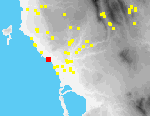 G02
Vromoneri Ayia Sotira
G02
Vromoneri Ayia Sotira
Site G2 is located ca. 1.2 km. S of Vromoneri, near the coast. It extends from high sea-cliffs at the W to a small hill ca. 500 hundred meters from the sea on the E. Much of the site is covered by weedy olive orchards. There are several occupied modern houses within it.
On top of the small hill are 13 rock-cut graves[073.02] and various other cuttings in the bedrock. In the field to the west there are several ashlar blocks.[073.01]
Approximately 150 m. to the SW of the graves, there is an abandoned two-storey house.[090.27][090.25] Its veranda is enclosed by a low wall with ornamental pillars; a bread-oven still stands next to the house. The basement is partly cut into bedrock. From the veranda there is an impressive view to the SE.
A wall with bevelled mortar moulding similar to those at Site G3 and Site C4 is attached to the wall of the house[090.28] and be traced for ca. 100 m.; it may once have continued to the coast and have been part of a large enclosure associated with the house. Near the site is a similar walled enclosure, its gateway preserved and there are other collapsed and collapsing walls of the same style in the vicinity.
Ca. 150 m. SW of the abandoned house and some 50 m. from the beach, there is a large buried structure of brick and mortar.[110.10] It appears to be divided into several compartments. It may have been a cistern, a storage facility, or even a catacomb. Diagnostic ceramic finds of the Hellenistic/Roman period cluster around this feature. Early Modern pottery was found all over the site.
The church of Ayia Sotira is located on the coast, several hundred meters north of Site G2. Valmin had previously reported architectural fragments in its vicinity.
Most of the material collected at Ayia Sotira was too worn to date accurately, but the predominant periods represented are Hellenistic-Roman and Early Modern. Hellenistic and Roman finds include plain ware bowls and storage vessels, as well as possible Laconian tile fragments. Early Modern pottery is characterized by fine wares such as plates with blue flower designs.